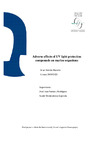Identificador persistente para citar o vincular este elemento:
https://accedacris.ulpgc.es/handle/10553/75822
| Campo DC | Valor | idioma |
|---|---|---|
| dc.contributor.advisor | Santana Rodríguez, José Juan | es |
| dc.contributor.advisor | Montesdeoca Esponda, Sarah | es |
| dc.contributor.author | Arronte Basulto, Iciar | es |
| dc.date.accessioned | 2020-11-23T10:55:18Z | - |
| dc.date.available | 2020-11-23T10:55:18Z | - |
| dc.date.issued | 2020 | - |
| dc.identifier.uri | https://accedacris.ulpgc.es/handle/10553/75822 | - |
| dc.description.abstract | The growing use of ultraviolet (UV) light protection compounds on a wide range of personal care products (PCPs), plastics, industrial products and textiles has turned them on chemicals of emerging concern, especially for marine habitats. UV compounds can reach marine habitat directly and indirectly via recreational bathing activities or trough discharge from wastewater treatment plants (WWTPs) respectively. The high bioavailability of these compounds makes them hazardous for marine organisms. It has been demonstrated the production of adverse effects of UV compounds on a wide range of marine organisms, from viruses to marine mammals, such as inhibition of body growth and weight, toxicity effects, disturbance on reproduction system, endocrine disruption properties or bleaching on corals. Due to the liphophility, persistence and stability of UV compounds, they bioaccumulate on different species of marine organisms and biomagnificate through food chain via predator-prey interactions. This converts them into harmful contaminants for human health, especially in countries with a high consumption of marine organisms, making necessary a study of their presence on food from local markets. The purpose of this work is to summarize the adverse effects that UV light protection compounds can produce on marine organisms, their capacity to bioaccumulate and biomagnificate on different species and their toxicity and risk for each type of organism | en_US |
| dc.language | eng | en_US |
| dc.subject | 2301 química analítica | en_US |
| dc.subject | 2391 Química ambiental | en_US |
| dc.subject.other | UV light protection compounds | es |
| dc.subject.other | UV filters | es |
| dc.subject.other | UV stabilizers | es |
| dc.subject.other | Marine organisms | es |
| dc.subject.other | Toxicity | es |
| dc.subject.other | Bioaccumulation | es |
| dc.subject.other | Biomagnification | es |
| dc.title | Adverse effects of UV light protection compounds on marine organisms | es |
| dc.type | info:eu-repo/semantics/masterThesis | en_US |
| dc.type | MasterThesis | en_US |
| dc.contributor.departamento | Departamento de Química | es |
| dc.contributor.facultad | Facultad de Ciencias del Mar | en_US |
| dc.investigacion | Ciencias | en_US |
| dc.type2 | Trabajo final de máster | en_US |
| dc.description.notas | Máster en Oceanografía ; 2019-2020 | en_US |
| dc.utils.revision | Sí | en_US |
| dc.identifier.matricula | TFT-57249 | es |
| dc.identifier.ulpgc | Sí | en_US |
| dc.contributor.buulpgc | BU-BAS | es |
| dc.contributor.titulacion | Máster Universitario en Oceanografía por la Universidad de Cádiz, la Universidad de Las Palmas de Gran Canaria y la Universidad de Vigo | es |
| item.grantfulltext | open | - |
| item.fulltext | Con texto completo | - |
| crisitem.advisor.dept | GIR IUNAT: Análisis Químico Medioambiental | - |
| crisitem.advisor.dept | IU de Estudios Ambientales y Recursos Naturales | - |
| crisitem.advisor.dept | Departamento de Química | - |
| crisitem.advisor.dept | GIR IUNAT: Análisis Químico Medioambiental | - |
| crisitem.advisor.dept | IU de Estudios Ambientales y Recursos Naturales | - |
| crisitem.advisor.dept | Departamento de Química | - |
| Colección: | Trabajo final de máster | |
Visitas
669
actualizado el 17-may-2025
Descargas
307
actualizado el 17-may-2025
Google ScholarTM
Verifica
Comparte
Exporta metadatos
Los elementos en ULPGC accedaCRIS están protegidos por derechos de autor con todos los derechos reservados, a menos que se indique lo contrario.
